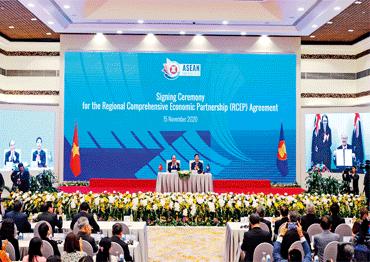While the signing of the RCEP led analysts to increasingly interpret the political significance of the RCEP and CPTPP primarily from the lens of the US-China rivalry, Beijing offered a different perspective. On November 20, days after the RCEP was signed, Chinese President Xi Jinping surprisingly announced at the virtual Asia-Pacific Economic Cooperation leaders’ meeting that China will actively consider joining the CPTPP.
This is not the first time Chinese leaders expressed interest in joining the bloc. In May, in response to a question by a Japanese journalist at a press conference at the end of the annual session of the 13th National People’s Congress, Chinese Premier Li Keqiang said that China has a “positive and open” attitude toward the idea of joining the CPTPP.
But unlike Li’s comments, which attracted no substantial coverage from China’s domestic media, Xi’s announcement was followed by a heated discussion among Chinese media and experts.
In a commentary released just a day after Xi’s announcement, CGTN, the English-language arm of China’s State-owned broadcaster China Central Television (CCTV) offered analysis to a question it posed in a commentary titled “Why is China now considering joining a bloc which was initially pitched as anti-China?”
“With the incoming Biden administration now on the horizon, China has decided the ‘strategic time’ is now right to actively consider joining the CPTPP,” said the commentary.
Acknowledging that the CPTPP has higher standards for participation than the RCEP, the commentary said that China is “sending a message of conciliation, not ambition, to those involved.”
Stressing that China’s pursuit of multilateralism does not “represent a zero-sum game of ‘win’ or ‘lose’ as has been depicted by the Trump administration,” the article said the CPTPP “should not be viewed in binary terms as a pro-China or anti-China coalition as many of its participants have free trade arrangements with China and are also part of the RCEP anyway.”
In another article published on November 21, the State-owned Global Times put it more directly. “China’s interest in joining the CPTPP would also create a new chance for China and the US to seek common ground and work out their divergences.”
In a commentary published on Jiemian.com on December 1, Su Qingyi, a senior research fellow and deputy head of the department of International Trade of the Institute of World Economics and Politics at CASS, noted that joining the CPTPP would be a major strategic focus for China’s future policy.
Arguing that most of the CPTPP rules converge with China’s reform targets, Su said that joining the CPTPP can address the concerns the West has over trade issues and enable China to fully integrate into the global trade system.
“If joining the World Trade Organization [in 2001] was China’s first phase of joining the global trade system and the global division of labor, China’s joining of the RCEP is the second phase, and its future joining in the CPTPP will be the third,” Su stated.
Regarding the prospect of the US rejoining the CPTPP under a Biden administration, Su said that China could propose joining the CPTPP at the same time as the US, although it would not be straightforward.
“The question for China is not whether or not to join the CPTPP, but how China could join it,” Su said.
On November 20, the same day that Xi expressed China’s interest in joining the CPTPP, Japanese Prime Minister Yoshihide Suga said that Japan aims to expand the CPTPP, although no specific mention was made of China. In June, the UK announced its intention to join the CPTPP. But even if Japan and other CPTPP members agree to start negotiations with China, it would take years before there is a concrete outcome.
According to Zhai Kun, a professor at the School of International Studies at Peking University in Beijing, a major problem with the ongoing discussion of the relationship between the RCEP and CPTPP is that the rivalry aspect of the relationship is exaggerated.
“While different trade pacts may compete with each other on some level, they can be supplementary as well,” Zhai told NewsChina.
“What is most important is to uphold the principle of multilateralism and free trade, which is key to the peace and prosperity of both Asia and the whole world.”

 Old Version
Old Version

